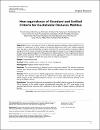Non-equivalence of Standard and Unified Criteria for Gestational Diabetes Mellitus
| Author | Hamdan, Ahmad |
| Author | Zar, Amna |
| Author | Alsharif, Fatima R. |
| Author | Abuhaweeleh, Mohannad N. |
| Author | Alwisi, Nouran |
| Author | Khudadad, Hanan |
| Author | Bashir, Khalid |
| Author | Beer, Stephen |
| Author | Bashir, Mohammed |
| Author | Abou-Samra, Abdul Badi |
| Author | Doi, Suhail A.R. |
| Available date | 2025-10-28T06:03:05Z |
| Publication Date | 2025-08-23 |
| Publication Name | Clinical Medicine and Research |
| Identifier | http://dx.doi.org/10.3121/CMR.2025.1974 |
| Citation | Hamdan, A., Zar, A., Alsharif, F. R., AbuHaweeleh, M. N., Alwisi, N., Khudadad, H., ... & Doi, S. A. (2025). Non-equivalence of Standard and Unified Criteria for Gestational Diabetes Mellitus. Clinical Medicine & Research, 23(2), 53-59. |
| ISSN | 1539-4182 |
| Abstract | Objective: There are two types of criteria for diagnosing gestational diabetes mellitus (GDM).The first is based on measurement of three values on the glucose tolerance test (GTT) and making a diagnosis when any value is abnormal (individual time-point criterion).The second is based on creating a weighted average of the three values and using the average to split glycemic status into normal gestational glycemia (NGG), impaired gestational glycemia (IGG), gestational diabetes (GDM), or high-risk gestational diabetes (hGDM) (unified criterion). There is no information currently regarding how these two criteria relate to each other in the diagnosis of GDM.This study aimed to make this comparison. Design: Cross-sectional study. Setting: Publicly available data on a cohort of women in pregnancy. Participants: Pregnant women from the cohort. Methods: The cross-classification of diagnosis by two criteria was evaluated. The individual time-point criterion had a binary outcome (GDM yes/no), while the unified criterion had the four aforementioned outcomes. Results: Within the low risk (non-GDM) category by the individual time-point criterion, 1 in 85 women would have been deemed at high risk by the unified criterion. More importantly, within the high risk (GDM) category by the individual time-point criterion, 1 in 2 women would have been deemed at low risk by the unified criterion. Conclusion: The standard criterion is not equivalent to the unified criterion in terms of risk estimation. This is important as the unified criterion correlates with area under the GTT curve known to be associated with glucose excursion and is predictive of the net effect of insulin resistance and beta-cell function. |
| Language | en |
| Publisher | Marshfield Clinic |
| Subject | Gestational Diabetes Mellitus OGTT Overdiagnosis Unified Criteria |
| Type | Article |
| Pagination | 53-59 |
| Issue Number | 2 |
| Volume Number | 23 |
Files in this item
This item appears in the following Collection(s)
-
Medicine Research [1921 items ]


